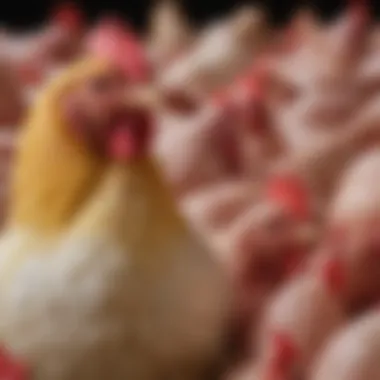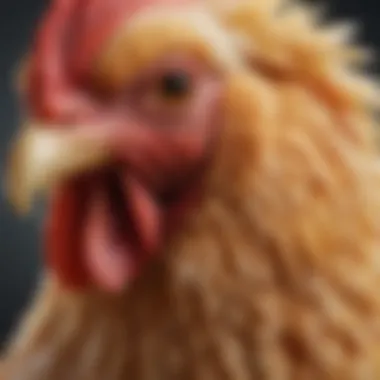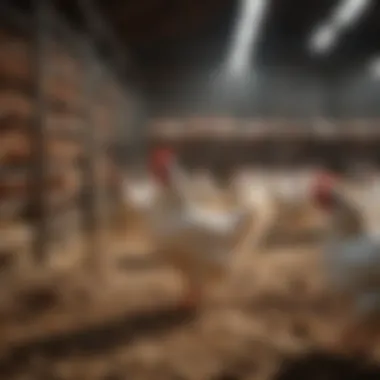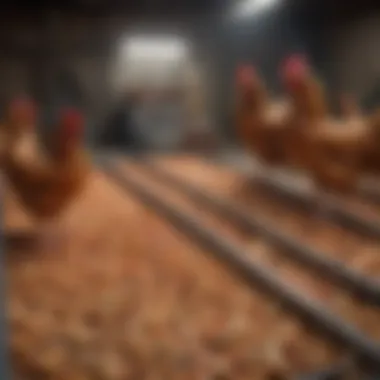The Ultimate Guide to Choosing the Best Meat Chicken Breed


Intro
In the world of poultry farming, selecting the right breed of meat chicken is crucial. Various factors come into play when determining which breed performs best in terms of growth, feed efficiency, and meat quality. This guide aims to explore different breeds of meat chickens while providing practical insights for both novice and experienced chicken farmers. Understanding the distinct characteristics of these breeds helps in making informed decisions that can significantly impact the success of poultry production.
Animal Overview
Common Name and Scientific Classification
The most common meat chicken breed is the Broiler chicken, scientifically classified as Gallus gallus domesticus. These chickens are specifically bred for meat production, focusing on traits that enhance their growth and feed conversion rates.
Physical Characteristics
Meat chickens, especially Broilers, are known for their distinctive physical characteristics. They typically have a rounded body shape, with robust muscle development, especially in the breast area. Their feathers may vary in color, with white and red being the most common hues. These chickens usually weigh between 4 to 5 kilograms at market age, which is around 6 to 8 weeks old. Their rapid weight gain is a key trait that distinguishes them from other poultry breeds.
Habitat and Distribution
Broiler chickens are adaptable and can thrive in various environments. They are commonly raised in intensive farming systems in many parts of the world, including North America, Europe, and Asia. The key to their habitat is adequate space and proper ventilation. Ensuring a clean environment is important to prevent diseases and maintain health.
Behavior and Social Structure
Communication Methods
Broiler chickens communicate using a variety of vocalizations. These range from soft clucking to loud squawking, often indicating distress or contentment. Understanding these sounds can help farmers monitor their flock's health and well-being.
Social Hierarchies
Chickens have a pecking order that establishes social structure. Within a flock, dominant birds assert control over resources such as food and space. Recognizing this hierarchy is important for successful flock management, as it affects feeding behaviors and overall flock dynamics.
Mating and Reproductive Behavior
While meat chickens are primarily raised for their meat rather than for breeding, some farmers may choose to focus on dual-purpose breeds that offer both meat and egg production. However, for pure meat production, broiler parents are kept separate to ensure high-quality chicks.
Conservation Status
Current Population Trends
Broiler chickens comprise a significant percentage of the poultry population globally. Their rapid growth and high demand have led to increased production practices.
Threats and Challenges
Conventional farming methods pose various threats. These include disease outbreaks, biosecurity risks, and ethical concerns regarding animal welfare. Such challenges necessitate careful management and attention to best practices.
Conservation Efforts and Success Stories
Sustainable farming practices are increasingly being adopted to address these challenges. Organizations focusing on welfare and sustainability have successfully promoted methods that enhance the living conditions of broilers while maintaining productivity.
“Informed choices about breeds and farming practices can lead to more sustainable poultry production.”
This exploration of meat chicken breeds provides a foundation for poultry farmers to enhance their production methods and select the right breed for their specific needs.
Preface to Meat Chickens
Meat chickens are a vital component of poultry farming, providing essential protein sources for many communities. In this article, we will explore the various breeds of meat chickens and their characteristics. Understanding these breeds is crucial for any farmer, whether novice or experienced, seeking to maximize their production efficiency.
Defining Meat Chickens
Meat chickens are specifically bred for the purpose of meat production. They differ significantly from laying hens, which are raised primarily for their eggs. The primary goal of raising meat chickens is to achieve optimal weight gain in a shorter period of time. Key characteristics include rapid growth rates, efficient feed conversion, and positive meat quality attributes, such as tenderness and flavor.
The genetics of these birds play a crucial role in defining their purpose. Most meat chickens on modern farms are hybrids bred for specific traits. For instance, the most common breed for meat production is the broiler, which has been selected for high growth rates and efficient feed conversion ratios. This clear separation between production goals is what distinguishes meat chickens from other types in the poultry industry.
Importance in Poultry Farming
The importance of meat chickens in poultry farming cannot be overstated. They represent a significant portion of the global poultry industry and contribute substantially to food security. Poultry production is not only efficient when compared to other livestock, but it also requires fewer resources, such as land and water.
Here are several points highlighting why meat chickens are key to poultry farming:
- Efficient Feed Conversion: Meat chickens generally convert feed into body mass effectively, resulting in lower costs for farmers.
- Rapid Growth: Breeds like broilers can reach market weight in as little as six weeks, providing quicker returns on investment.
- Market Demand: There is a consistent demand for chicken meat in many diets, ensuring a stable market for farmers.


The integration of effective breeding practices and management techniques ensures optimal production and meat quality.
These aspects, combined with good farming practices, make meat chickens a cornerstone of poultry production worldwide.
Overview of Chicken Breeds
Understanding the various breeds of chickens is essential for anyone involved in poultry farming. Each breed harbors unique traits that can significantly affect production efficiency, meat quality, and overall farming success. This section provides a foundation for comprehending these differences, which is crucial for making informed decisions about which breed to choose for meat production.
Classification of Chicken Breeds
Chicken breeds are often categorized based on specific criteria that include their purpose, size, and growth characteristics. Breeds can primarily be classified into two categories: meat chickens and egg-laying chickens.
Meat chickens are generally bred for their rapid growth and high meat yield. Common breeds in this category include Broilers and Cornish chickens. They have been selectively bred over generations to achieve desirable weight and body conformation, leading to superior meat production.
On the other hand, egg-laying breeds focus on high egg production rather than meat yield. These include breeds such as Leghorns and Rhode Island Reds, known for their prolific laying capabilities. Understanding this classification helps farmers optimize their operations according to their specific goals, whether for meat or eggs.
Differences Between Layers and Meat Breeds
The differences between layers and meat breeds are significant and impact various aspects of poultry farming.
- Growth Rates: Meat breeds are designed for fast growth, reaching market weight in a matter of weeks. In contrast, layers grow at a slower pace but continuously produce eggs during their laying cycles.
- Feed Efficiency: Meat breeds often require specific feeding strategies to maximize growth while layers require a steady diet that supports egg production.
- Physical Characteristics: Meat chickens tend to have larger breasts and a more robust body compared to layers, which are generally slimmer and more agile.
These distinctions are critical when selecting the appropriate chicken breed for a farming operation. Knowing whether the focus is on meat production or egg-laying will determine the choice of breed, impacting feed management, housing, and overall care strategies.
Top Breeds of Meat Chickens
Understanding the top breeds of meat chickens is critical for anyone involved in poultry farming. The choice of breed directly influences various aspects such as growth rates, meat quality, and overall efficiency of production. Each breed offers unique traits, making some more suitable for certain conditions or farming practices.
Choosing the right meat chicken breed leads to healthier birds and better financial returns. Let's delve deeper into some of the most popular breeds, focusing first on Broiler Chickens.
Broiler Chickens
Characteristics of Broilers
Broiler chickens are primarily bred for meat production. They are known for their rapid growth and efficient feed conversion. One striking characteristic is their robust body structure, which supports a larger muscle mass. This makes them a popular choice among farmers who seek quick returns on investment.
Broilers typically reach market weight in a short span, usually around six to seven weeks. This speedy growth is beneficial as it allows producers to cycle through flocks quickly, thus maximizing profits. Also, their adaptability to various housing conditions makes them favorable for both small and large-scale operations. However, their rapid growth can lead to health issues if not managed properly.
Growth Rates
The growth rate of broilers is one of their most appealing features. Average daily gain can reach up to 200 grams per day. This means a farmer can maximize production cycles effectively. A quick turnover not only increases meat supply but also enhances cash flow.
The main disadvantage is that as broilers grow quickly, they may require careful management to prevent leg disorders. These health concerns should be monitored diligently, as they can lead to significant losses.
Feeding Requirements
Feeding broilers requires a specific strategy that focuses on growth-enhancing nutrients. A high-protein diet is essential in the early life stages. The right feeding strategy leads to better weight gain and overall health.
Farmers must also consider the cost of feed, which can be the largest expense in raising broilers. While well-formulated feed ensures efficiency, it is crucial to balance nutrient composition to avoid overexpenditure.
Cornish Chickens
Unique Traits
Cornish chickens stand out due to their unique morphology and strength. They possess broad breasts and are muscular. This characteristic makes them a favorite in the market for high-quality meat.
Their strong physique contributes to their remarkable feed conversion ratio, making Cornish a highly efficient option. However, they may require more attention regarding housing since their large body size can lead to stress in cramped conditions.
Meat Quality
The meat quality of Cornish chickens is notable. It is often described as juicy and tender, appealing to consumers. This high-quality meat is a crucial factor that can differentiate it in competitive markets, allowing for premium pricing.
While the high quality is advantageous, the birds may take longer to reach optimal size compared to other breeds. This can impact profit margins if farmers are not prepared for the longer production cycle.
Breeding Considerations
Breeding Cornish chickens requires a strategic approach to maintain desirable traits. Selecting the right genetics ensures consistent growth and meat quality. Additionally, breeders should consider potential health issues that may arise due to their size, such as cardiovascular problems.
Proper breeding methods can enhance the resilience of this breed while retaining their unique qualities. Farmers must be knowledgeable about breeding stock selection to ensure sustainable production.


Red Ranger Chickens
Hardiness and Adaptability
Red Ranger chickens are valued for their hardiness and adaptability. They thrive in diverse environments and are less susceptible to disease compared to other breeds. This durability is a significant benefit for farmers operating in challenging conditions.
Their adaptability correlates with lower mortality rates, which can enhance profit margins. However, while Red Rangers are robust, they may not grow as fast as some other meat breeds.
Feeding Efficiency
In terms of feeding efficiency, Red Rangers do well despite their slower growth rates. They utilize feed effectively, minimizing waste during growth. This feeds efficiency contributes to overall cost-effectiveness, especially for smaller farming operations.
Balancing feed types can further optimize their growth, but their lower feed conversion ratio in comparison to Broilers should be considered when planning.
Market Appeal
The market appeal of Red Ranger chickens lies in their heritage breed status, which attracts niche markets. Consumers increasingly prefer locally sourced, pasture-raised chickens due to health and environmental considerations.
Farmers can capitalize on this trend by promoting their products as sustainably raised birds. However, the slower growth can challenge rapid market demands, requiring farmers to plan accordingly.
Jersey Giant Chickens
Growth Patterns
Jersey Giant chickens are known for their distinct growth patterns, being one of the largest chicken breeds. Reaching maturity can take longer than average, often extending to six months. Despite this slow maturation, they present a significant amount of meat when fully grown.
This quality makes them appealing for specific markets where size matters. However, the extended growth period can limit their commercial viability for mass production.
Dual-Purpose Characteristics
One of the cornerstones of the Jersey Giant is its dual-purpose nature. Farmers can gain from both meat and egg production, increasing the value of each bird. Although egg production is not on par with dedicated layers, it does provide a steady secondary income.
Balancing the expectations for meat and egg yield can determine how effective this breed is for a specific operation.
Comparison to Other Breeds
When comparing Jersey Giants to cother meat breeds, their larger size is a notable advantage. However, the time taken to reach market weight may deter some farmers. This breed's profitability hinges on market demands. Farmers must conduct thorough market analysis to justify the extended growth time.
Growth and Care Aspects
The realm of meat chicken farming is not complete without understanding the critical growth and care aspects involved. Proper management practices can significantly affect the health, growth rates, and meat quality of chickens. Focusing on these elements supports not only the immediate well-being of the birds but also contributes to long-term profitability in a poultry operation. Understanding growth patterns, feeding strategies, and housing needs become essential for effective meat chicken production.
Best Practices for Raising Meat Chickens
The first step in successful meat chicken farming lies in adhering to best practices. These practices encompass several stages, from selecting healthy chicks to managing their environment effectively. Here are some key points:
- Select Healthy Chicks: Choose birds from reliable hatcheries that test for common diseases.
- Monitor Health: Regularly check for signs of illness or distress, providing prompt veterinary care if needed.
- Maintain Hygiene: Keep the brooding area clean to prevent disease. Use disinfectants regularly when cleaning buildings.
- Vaccination Programs: Implement vaccination schedules to protect flocks from preventable diseases.
By incorporating these practices, farmers can significantly enhance the resilience and productivity of their meat chickens.
Feeding Strategies
Feeding strategies are integral to raising meat chickens successfully. The right nutrition is pivotal for growth rates and overall health. Here are several feeding strategies:
- Starter Feed: Provide a high-protein starter feed at the beginning stages to promote rapid growth. Look for feeds containing at least 20-24% protein.
- Grower Feed: After a few weeks, switch to a grower feed that balances energy and protein for continued growth, typically around 18-20% protein.
- Finisher Feed: Near maturity, transition to finisher feed, which focuses on maximizing weight gain with around 15-18% protein.
- Monitor Feed Intake: Ensure that chickens have constant access to fresh feed and water. Assess feed intake daily to identify any issues.
Implementing these feeding strategies can lead to efficient growth and better meat quality, which is key for profitability.
Housing Requirements
Creating an ideal housing environment is fundamental in raising meat chickens. Housing plays a significant role in preventing stress and ensuring that chickens reach their growth potential. Important housing considerations include:
- Space Requirements: Provide at least 1 square foot of floor space per bird to allow for natural movement and reduce stress.
- Ventilation: Ensure proper air circulation to avoid humidity buildup and ammonia accumulation, which can harm respiratory health.
- Bedding Material: Use clean bedding such as straw or wood shavings to absorb moisture and keep the chicken house clean.
- Temperature Control: Maintain an appropriate temperature range. Chicks require warmer conditions initially; as they grow, gradually lower the temperature to 70-75°F.
Creating a comfortable and clean housing setup enhances the overall welfare and productivity of meat chickens, leading to a successful farming operation.
Meat Quality Considerations
Understanding meat quality is essential in poultry farming. It has implications not just for farmers but also for consumers and marketplaces. Quality meat is more than a mere consumer preference; it affects profitability, marketability, and overall operational success.


Meat quality can be assessed through various specific elements. Factors such as texture, flavor, color, and fat content all play an important role. These characteristics determine not just consumer satisfaction but also the price point in the market. Higher quality meat typically commands a better price, directly benefiting farmers.
Another crucial aspect of meat quality is the ability to meet industry standards. Different markets have varying requirements. For example, organic or antibiotic-free meat often attracts a premium price. Aligning with these expectations can significantly influence a farmer’s profitability.
Furthermore, health and safety considerations are increasingly becoming a concern. Consumers are more aware of how meat quality relates to their health. The presence of pathogens, for example, is a significant factor in meat quality assessments. Therefore, maintaining high standards in poultry health and handling directly affects meat quality.
"Quality meat influences not just customer satisfaction but also market trends and prices."
To provide quality meat, effective breeding and husbandry practices are essential. Farmers must focus on feeding and management strategies that enhance meat traits. These include optimizing diet, monitoring health, and ensuring stress-free environments. All these considerations together shape the meat quality output, making it a central focus in poultry production.
Assessing Meat Quality
Assessing meat quality involves multiple parameters. Tenderness is a vital factor that consumers often seek. This can be quantified through various methods. For instance, objective measurements, like shear force tests, provide insight into tenderness levels. Another assessment is through subjective measures, which include expert tasting panels that evaluate flavor profiles.
In addition to tenderness, marbling is also a key quality indicator. Good marbling, or the amount of intramuscular fat, affects both flavor and juiciness. It is often an indicator of a well-fed bird. Farmers must understand how diet impacts marbling to produce desirable results.
The color of the meat is another crucial factor. It influences consumer perception of freshness and quality. Consistency in color is often achieved through effective feed strategies that provide the necessary nutrients.
In summary, assessing meat quality requires a holistic approach. A combination of objective scientific tests and subjective evaluation will provide a comprehensive view of meat characteristics.
Market Trends in Poultry
Market trends in poultry demonstrate shifting consumer preferences and technological advancements. Today, health-conscious consumers are driving demand for higher quality products. This is evident in the surge for organic and free-range options. Farmers adapting to these trends can position themselves favorably in the marketplace.
Sustainability is another emerging trend. Environmental concerns are pushing consumers to prefer chicken sourced from farms that focus on eco-friendly practices. This includes reduced antibiotic use and improved welfare conditions. As awareness grows, farmers must align their practices to meet these demands.
Additionally, online buying has transformed market accessibility. Consumers increasingly value transparency about sourcing and production methods. This has made it essential for farmers to effectively communicate their practices, often through digital platforms.
To sum up, staying informed about market trends helps farmers make strategic decisions. Understanding consumer needs can guide breeding and management practices, optimizing both quality and profitability in meat production.
Economic Factors in Choosing Breeds
The economic aspect of selecting meat chicken breeds holds significant weight in poultry farming. It is crucial not only for achieving profitability but also for ensuring sustainable farming practices. Each breed has different costs associated with its care, from feed to healthcare and housing requirements. Understanding these economic factors aids farmers in making informed choices that lead to better financial outcomes. Considerations such as initial investment, ongoing operational costs and potential return on investment are all essential components of this evaluation.
Cost of Raising Different Breeds
The cost structure associated with raising various breeds of meat chickens varies widely. For example, Broiler chickens tend to have lower start-up costs due to their rapid growth rates and feed efficiency. In fact, they often reach market weight in around six to eight weeks. Other breeds, like the Jersey Giant, may require a longer growth period, thus increasing overall costs for feed and facility maintenance.
Some key elements that can influence costs include:
- Initial purchase price of chicks – Some breeds are more expensive than others.
- Feed consumption – Variance in required feed can greatly affect budget.
- Healthcare needs – Some breeds are more susceptible to diseases, increasing vet costs.
- Housing requirements – Space and infrastructure vary based on the breed and their growth patterns.
Profitability of Various Breeds
Profitability is a crucial consideration when choosing the right meat chicken breed. Factors such as market demand, growth rates, and feed conversion ratios directly affect financial returns.
For instance, Cornish chickens are highly sought after for their meat quality and flavor, often making them a more profitable option despite higher initial costs. On the other hand, Red Ranger chickens, known for their hardiness and adaptability, may offer lower profit margins but can be easier to raise in diverse conditions.
Some critical factors influencing profitability include:
- Market demand – Certain breeds may sell for higher prices based on consumer preferences.
- Growth rate – Faster-growing breeds can enhance turnaround on investment.
- Feed efficiency – How well a breed converts feed into body mass can impact overall profitability.
"Choosing the right breed of meat chicken is not just about personal preference. It requires a strategic approach that considers both economic factors and market trends."
In summary, the economic factors of choosing meat chicken breeds are multifaceted. By understanding these elements, farmers can align their operations with a breed that not only meets their market needs but also supports a profitable business model.
Epilogue
The conclusion of this article serves multiple purposes. It encapsulates the essential points discussed and summarizes the characteristics and benefits of the various meat chicken breeds. Understanding these elements helps poultry farmers make informed decisions based on their specific needs and operational goals.
Summary of Key Insights
Throughout the previous sections, we explored several key insights that illuminate the best practices for selecting meat chicken breeds. Key highlights include:
- Growth Rates: Different breeds exhibit varying growth speeds, making some more favorable for rapid turnover in poultry farming.
- Feed Efficiency: Certain breeds have optimized feed-to-meat conversion ratios, a critical element in maximizing profits.
- Meat Quality: The flavor, tenderness, and overall quality of meat vary across breeds, influencing market demand.
- Economic Factors: Costs associated with raising each breed can greatly impact overall profitability, urging careful financial consideration.
These insights allow farmers to align their breed choices with market trends, consumer preferences, and individual business strategies.
Considerations for Future Poultry Farming
As the poultry landscape continually evolves, several considerations for future poultry farming emerge:
- Sustainability Practices: Emphasizing sustainable methods of farming fosters long-term viability and addresses consumer concerns about ethical practices.
- Genetic Research: Ongoing developments in genetic improvements may yield breeds that are not only faster-growing but also hardier and more disease-resistant.
- Market Adaptability: Farmers should keep an eye on changing consumer preferences and market demands to adapt swiftly and maintain profitability.
- Technology Integration: Using technology for breeding, tracking growth, and managing feed can optimize operations and improve outcomes.
In summary, the future of poultry farming will rely heavily on adaptability, sustainability, and strategic planning. By understanding the intricacies of meat chicken breeds, farmers can navigate the challenges ahead and continue to thrive in this competitive industry.







